The Monk Fruit Ingredient Market is estimated to be valued at USD 194.1 million in 2025 and is projected to reach USD 307.2 million by 2035, registering a compound annual growth rate (CAGR) of 4.7% over the forecast period.
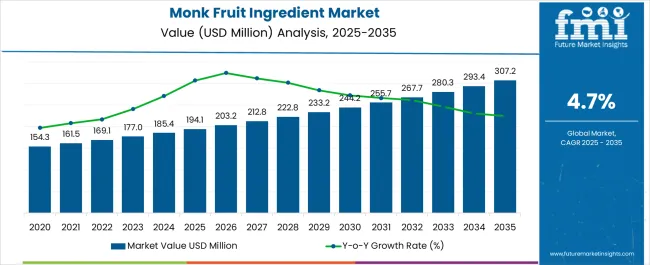
| Metric | Value |
|---|---|
| Monk Fruit Ingredient Market Estimated Value in (2025 E) | USD 194.1 million |
| Monk Fruit Ingredient Market Forecast Value in (2035 F) | USD 307.2 million |
| Forecast CAGR (2025 to 2035) | 4.7% |
The monk fruit ingredient market is gaining traction due to rising demand for clean-label, plant-based sweeteners and increasing awareness regarding sugar reduction in food and beverage formulations. With regulatory bodies and health organizations globally encouraging lower sugar intake, monk fruit has emerged as a preferred natural alternative, offering zero-calorie sweetness without compromising taste.
Technological advancements in extraction and purification processes have improved ingredient stability, enabling broader incorporation into complex product matrices. Rising diabetic population, consumer shift toward low glycemic index diets, and growth in ketogenic and functional food segments have further enhanced demand.
The market outlook is reinforced by collaborations between ingredient manufacturers and food brands, focused on formulating products that cater to both health-conscious and taste-sensitive consumer bases. Continued product launches and investments in sustainable farming of monk fruit are anticipated to support long-term industry growth.
The market is segmented by Product Type, Application, and Form and region. By Product Type, the market is divided into Monk Fruit Sweeteners and Monk Fruit Extracts. In terms of Application, the market is classified into Food and Beverages, Bakery and Confectionery, and Pharmaceutical. Based on Form, the market is segmented into Dry and Liquid. Regionally, the market is classified into North America, Latin America, Western Europe, Eastern Europe, Balkan & Baltic Countries, Russia & Belarus, Central Asia, East Asia, South Asia & Pacific, and the Middle East & Africa.
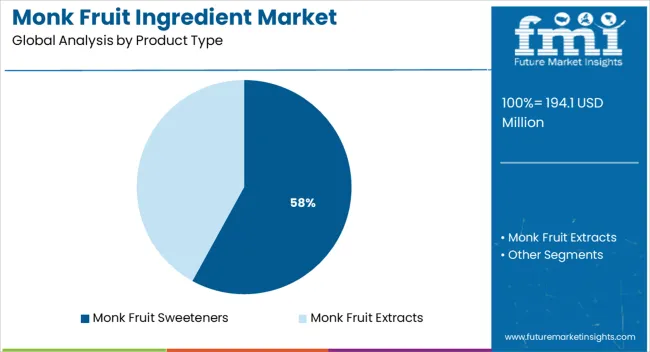
Monk fruit sweeteners are projected to lead the market with 58.0% revenue share in 2025. This leadership is being driven by their zero-calorie composition, natural origin, and high-intensity sweetness profile, which makes them suitable replacements for traditional sugars in a variety of applications.
Adoption has been encouraged by clean-label initiatives and regulatory approvals across major food economies. Food manufacturers are increasingly utilizing monk fruit sweeteners in low-sugar and sugar-free product lines to meet rising health and wellness expectations.
Their ability to blend well with other natural sweeteners and mask bitter aftertastes has enhanced formulation flexibility, further strengthening their preference across both mainstream and specialty food categories.
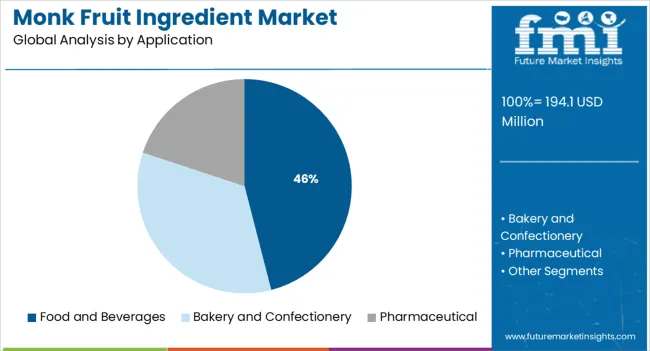
The food and beverages segment is forecast to contribute 46.0% of the total revenue in 2025, positioning it as the largest application segment. This dominance is driven by extensive integration of monk fruit in dairy alternatives, bakery items, functional beverages, and confectionery.
Increasing demand for sugar reduction across global product portfolios and a surge in consumer interest toward healthier indulgences have accelerated its adoption. Reformulation initiatives by major brands to reduce added sugars without compromising flavor are supporting segment expansion.
The compatibility of monk fruit with both hot and cold processing has further widened its use in ready-to-drink and ready-to-eat segments, aligning with convenience-focused consumption trends.
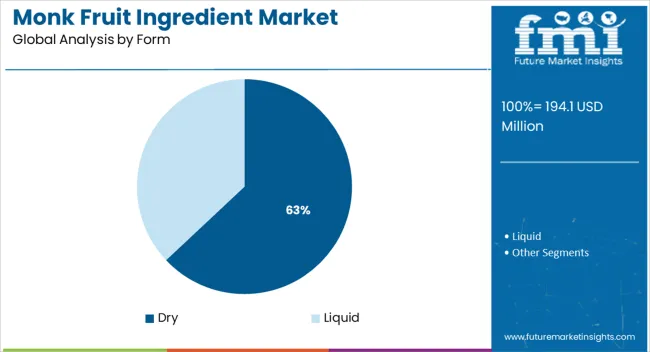
Dry form is expected to hold 63.0% of the monk fruit ingredient market revenue in 2025, establishing it as the dominant format. This preference is attributed to its longer shelf life, ease of transport, and compatibility with powdered and solid food formulations.
Dry monk fruit extracts are widely adopted by food processors due to their low moisture content, which facilitates stable storage and cost-effective logistics. The form also offers greater flexibility in dosage control and formulation during manufacturing.
The increasing popularity of dry mixes, supplement powders, tabletop sweeteners, and pre-mix sachets has further solidified the dominance of this segment. Its suitability for large-scale industrial use continues to make it the preferred format across various food and beverage production lines.
The Global Market for Monk Fruit Ingredient increased from USD 154.3 Million to USD 162.8 Million between2020 and 2024 with a CAGR of 3.9%.
The market for Monk Fruit Ingredient is anticipated to be driven by its favourable health effects, anti-inflammatory and antioxidant capabilities, high nutritional content, and superior flavour. Due to the growing trend of consumers favouring clean-label foods and beverages, and the rising demand for natural sweeteners in foods and beverages can also be attributed to the Monk Fruit Ingredient industry's explosive expansion.
During the forecast period, the global Monk Fruit Ingredient Market is anticipated to grow from USD 194.1 Million in 2025 to USD 307.2 Million by 2035 with a healthy CAGR of 4.7%.
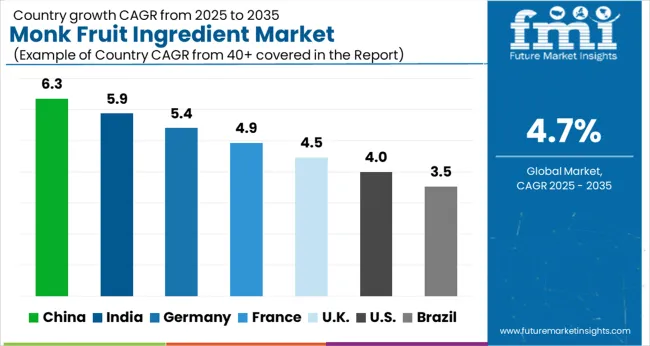
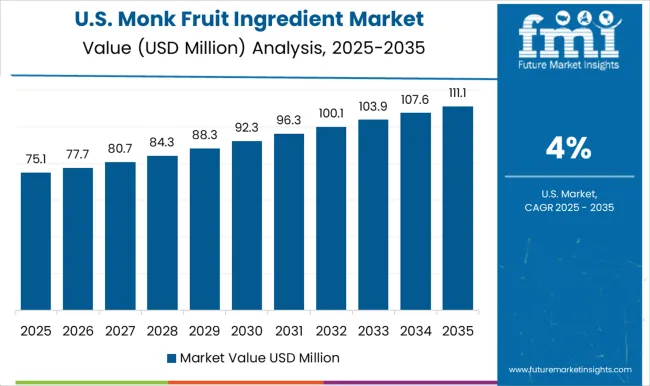
The US Monk Fruit Ingredient market is shaping up to be a leader in the global market. The market is being driven by the increasing demand for monk fruit sweeteners and the growing popularity of monk fruit products. Monk fruit is a natural sugar substitute that is made from the extract of the monk fruit plant. The monk fruit extract is 300 times sweeter than sugar and has zero calories. It is also a rich source of antioxidants.
The US Monk Fruit Ingredient Market is expected to reach USD 194.1 million andaccount for 34% of the global market by 2025.
According to projections, North America will account for a significant portion of the global market for Monk Fruit Ingredients. Some of the main factors driving the expansion of Monk Fruit Ingredients in North America are the shift in demand from synthetic to natural compounds along with increasing health awareness.
Monk fruit is claimed to have acquired its name from the Buddhist monks who first produced it about eight hundred years ago. Monk fruit is not only nutritious but also has significant cultural importance in China. The monk fruit and its genetic material cannot be grown outside of China, according to the Chinese authorities. As a result, it is exclusively produced in China.
The China Monk Fruit Ingredient Market will grow at 3.7% CAGR between 2025 and 2035.
The India Monk Fruit Ingredient Market will grow at 3.5% CAGR between 2025 and 2035. The country is also one of the largest producers of fruits and vegetables, making it a key player in the global Monk Fruit Ingredient market. The Monk Fruit Ingredient market is growing rapidly due to the increasing demand for natural sweeteners.
The sweetness of monk fruit has made it a popular choice as an ingredient in many beverages. Its positive impact on blood sugar levels and lack of calories has made it a popular choice for those looking for a healthier alternative to sugar. Monk fruit is also a good source of antioxidants and has been shown to have anti-inflammatory properties.
the monk fruit extract is available in both liquid and powder form. The liquid form is more concentrated, so you'll need to use less of it to sweeten your food or drink.
Liquid Monk Fruit extract is a great way to add sweetness to your favorite foods and drinks without adding any calories. It's also a good choice for people with diabetes or who are trying to lose weight.
Mogroside, an ingredient found in monk fruit, has a number of health advantages. As an antioxidant, mogroside aids in lowering the body's exposure to free radical damage. Ingredients in monk fruit aid in the prevention of diabetes and obesity. Ingredients from monk fruit also have anti-inflammatory and anti-carcinogenic actions, which means they aid in the treatment and prevention of cancer.
Inhibiting the growth of germs, especially oral bacteria that cause oral illnesses, is aided by the antibacterial and antimicrobial characteristics of Monk Fruit Ingredient.
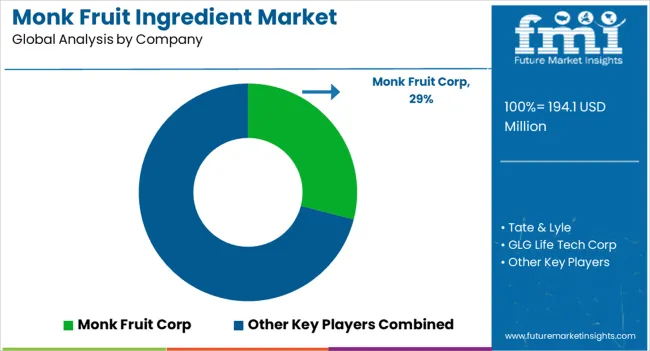
Companies competing in the Monk Fruit Ingredient industry are concentrating on launching new products in order to diversify their product offering.
In recent years, the Monk Fruit Ingredient market has become increasingly competitive. A number of large companies have entered the market, and many smaller companies are struggling to survive. Smaller companies are at a disadvantage in the Monk Fruit Ingredient market because they lack the resources to invest in research and development or to offer lower prices. The competition is fierce, and prices are falling.
| Attribute | Details |
|---|---|
| Forecast Period | 2025 to 2035 |
| Historical Data Available for | 2020 to 2025 |
| Market Analysis | USD Million for Value and Units for Volume |
| Key Regions Covered |
North America; Latin America; Europe; Asia Pacific; Middle East Africa (MEA) |
| Key Countries Covered |
India, The USA, Germany, China, Japan, Denmark, Canada, Mexico, Poland, The UK, Turkey, France, Italy, Spain, South Korea, Russia, Australia, Brazil, Argentina, South Africa. |
| Key Segments Covered |
Product Type, Application, Form, Region. |
| Key Companies Profiled |
Guilin LAYN Natural Ingredients Corp; Tate Lyle; GLG Life Tech Corp; Monk Fruit Corp; Archer Daniels Midland Co. |
| Report Coverage | DROT Analysis, Market Forecast, Company Share Analysis, Market Dynamics and Challenges, Competitive Landscape, and Strategic Growth Initiatives |
| Customization Pricing | Available upon Request |
The global monk fruit ingredient market is estimated to be valued at USD 194.1 million in 2025.
The market size for the monk fruit ingredient market is projected to reach USD 307.2 million by 2035.
The monk fruit ingredient market is expected to grow at a 4.7% CAGR between 2025 and 2035.
The key product types in monk fruit ingredient market are monk fruit sweeteners and monk fruit extracts.
In terms of application, food and beverages segment to command 46.0% share in the monk fruit ingredient market in 2025.






Full Research Suite comprises of:
Market outlook & trends analysis
Interviews & case studies
Strategic recommendations
Vendor profiles & capabilities analysis
5-year forecasts
8 regions and 60+ country-level data splits
Market segment data splits
12 months of continuous data updates
DELIVERED AS:
PDF EXCEL ONLINE
Monkeypox Treatment Market - Drug Developments & Demand Forecast 2025 to 2035
Monk Fruit Sugar Market Analysis by Nature, Form, End Use, Packaging Type and Sales Channel Through 2035
Fruit Punnet Market Forecast and Outlook 2025 to 2035
Fruit And Vegetable Juice Market Size and Share Forecast Outlook 2025 to 2035
Fruit Pomace Market Size and Share Forecast Outlook 2025 to 2035
Fruit Processing Equipment Market Size and Share Forecast Outlook 2025 to 2035
Fruit Tea Market Analysis - Size, Share, & Forecast Outlook 2025 to 2035
Fruit Beverages Market Size, Share, and Forecast 2025 to 2035
Fruit Powders Market Trends - Growth, Demand & Forecast 2025 to 2035
Fruit Jams, Jellies, and Preserves Market Analysis by Type, Distribution Channel, and Region Through 2035
Fruit Wine Market Analysis by Platform, By Application, By Type, and By Region – Forecast from 2025 to 2035
Fruit Beer Market Analysis by Flavor Type, Alcohol Content, Packaging Type, and Sales Channel Through 2035
Competitive Breakdown of Fruit Snacks Suppliers
Fruit Concentrate Puree Market Growth - Trends & Forecast 2025 to 2035
Fruit Snacks Market Analysis by Product Type, Nature, Flavour Type, Distribution Channel Type, and Processing Type Through 2035
Analysis and Growth Projections for Fruit Pectin Business
Market Share Insights of Fruit Juice Packaging Providers
Fruit Juice Packaging Market Growth – Trends & Forecast through 2035
Global Fruits and Vegetable Bag Market Growth – Trends & Forecast 2024-2034
Fruit Kernel Products Market

Thank you!
You will receive an email from our Business Development Manager. Please be sure to check your SPAM/JUNK folder too.
Chat With
MaRIA